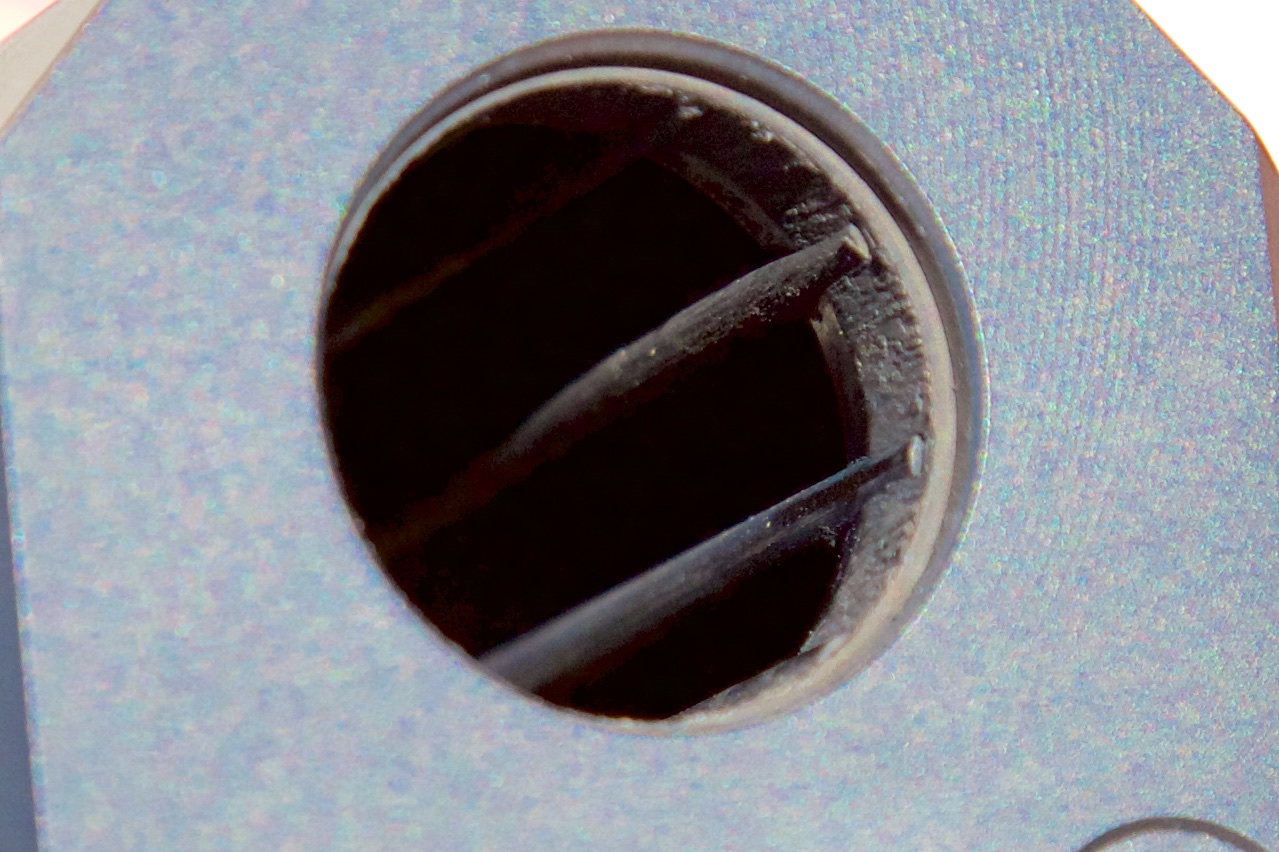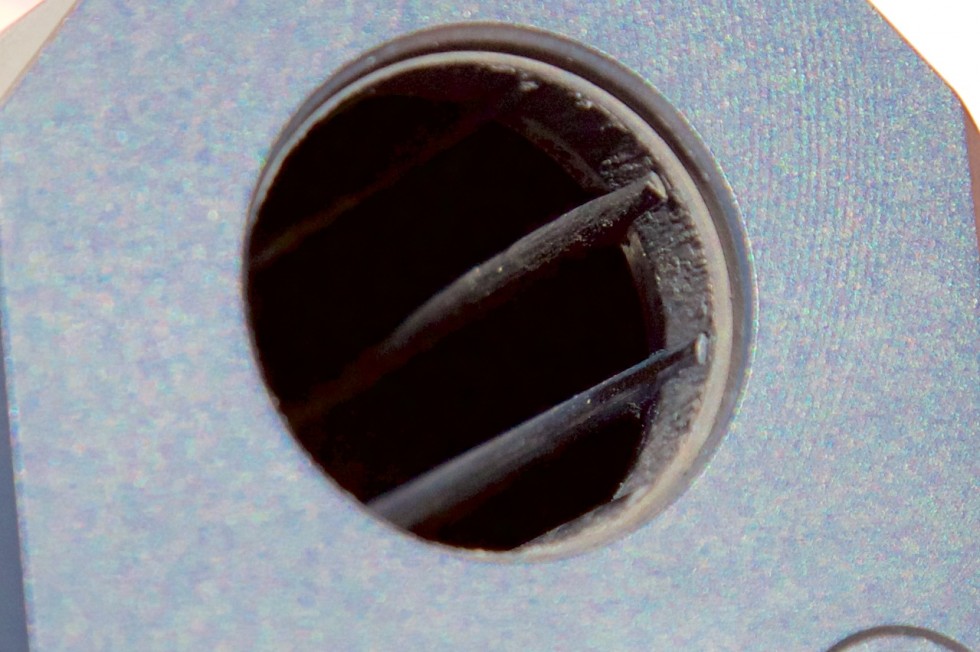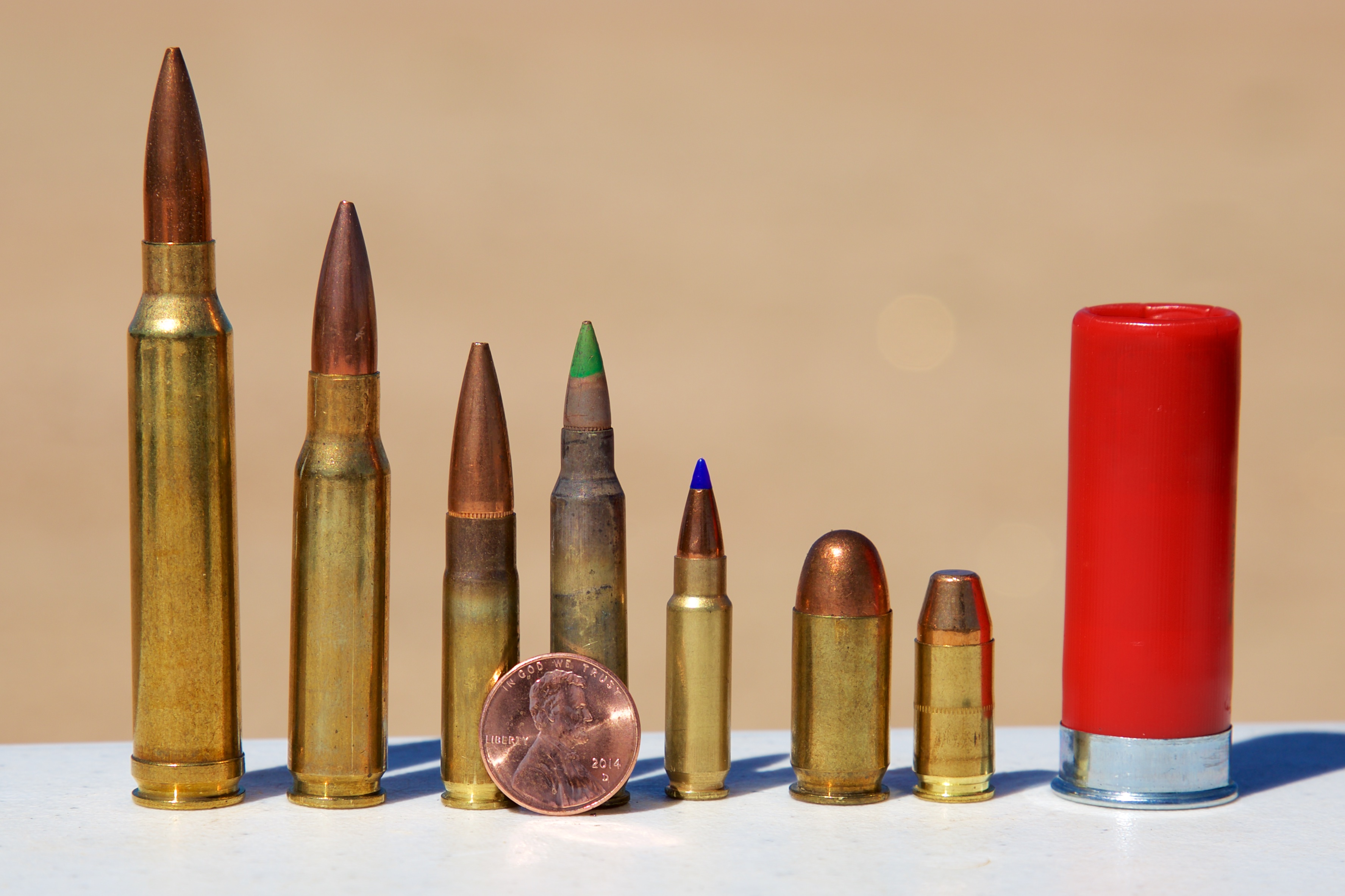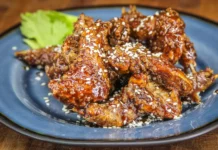Table of Contents
Pulling out the big guns—like, actually for-real
We had three weapons left to shoot, and they were all large—large guns that fired large rounds. Each used a different type of round, but all of them were definitely of the “big” variety.
First up was that most complex of beasts to silence: the shotgun. The challenges in quieting a shotgun are legion—the biggest, as we mentioned earlier, is that a shotgun might shoot a multitude of different ammunition types (including many different types of shot), with different chokes, under many different circumstances. The proverbial “one suppressor to rule them all” is a difficult engineering challenge to tackle.
SilencerCo’s solution is the Salvo, which looks like a scaled up version of the eccentric Osprey. Its slab sides and beveled edges actually give it an elegant appearance, in spite of its size. A peek into the business end of the device reveals the feature that lets the suppressor cope with the wide variety of things that can be crammed inside a shotgun shell and the fact that shot typically expands when fired. The Salvo has a twisty set of rods, running the length of the suppressor.

“The key to it all was, what do you do with the wadding?” explained Schauble, referring to the three-part plastic framework inside each shotgun shell that contains the shell’s payload. Past attempts to suppress shotguns with traditional silencers usually resulted in the shot expanding too fast and actually ripping into the silencer itself, or the round’s wad would shred and foul the bore.
The solution was to drop a removable set of rods into the suppressor’s bore, which guide the wadding and the shot out. The rods, Schauble elaborated, keep the wadding and shot contained until they exit the suppressor while still allowing the round’s gases to be trapped and muffled. If the wadding does fragment before it makes it out of the barrel, it’s shunted into the bottom of the suppressor without affecting the suppressor’s performance, and it can be dumped out later.
The suppressor design means that the shot’s spread pattern is unaffected, with the effect of the suppressor basically being like having a longer barrel on the shotgun. This means that target shooters who want to affix chokes can still do so, and the choke will have the exact same effect as it would on the unsuppressed shotgun.
The Salvo is designed for use with 12 gauge shotguns, and it comes in four different lengths. Each length adds more weight and more suppression. At the lower end, the 6″ model doesn’t provide a ton of suppression (149db measured at the muzzle and 140.6db at the ear), but it does at least cut down some on the shotgun’s report; the full 12″ version we fired cuts the SPL down to 137db at the muzzle and 132db at the ear.
I’ve fired even fewer shotguns than I’ve fired ARs, but there was something supremely satisfying about the KA-CHUNK KA-CHUNK the big Remington 870 made when we cycled its action. We were firing regular 7½ shot, suitable for small game, and the amount of noise produced by the imposing-looking weapon was just not at all in line with what you’d expect. As with most of the rest of the day’s weapons, it was loud but not “it hurts” loud.
Shotguns are touted as the archetypical home defense weapon, and it’s easy to see that a suppressor fitted onto the end of a tactical-length shotgun would produce a weapon that isn’t unwieldy to handle indoors and would also leave you able to hear after firing. If the Salvo has any downsides, it’s the $1,400 price tag—depending on the shotgun, this might be up to three times the cost of the weapon you’re attaching it to.
Advertisement
Sniping with an actual sniper rifle
The penultimate weapon we fired was Schauble’s third-generation pre-production XM2010 military sniper rifle, which Schauble owns because he was part of the rifle’s development for the US Army during his time at Remington Arms. The XM2010 is a development model, so it’s close—but not identical—to the actual M2010 Enhanced Sniper Rifle being fielded with the Army. It’s a futuristic-looking weapon, with a very spare frame fitted all over with rails and all kinds of adjustment knobs, and it used the largest round we fired on the range that day: .300 Winchester Magnum.
This is the same round fired by most of the TrackingPoint XS-class rifles we’ve previously shot, and unsuppressed those weapons were teeth-rattlingly loud. Even capped off with SilencerCo’s Harvester rifle suppressor, the sound produced was still loud and had a physical component—you could feel the blast through your cheek and in your eyeballs when you fired, and the dirt around the rifle’s barrel would whuff up in a small cloud of dust with each shot. A single suppressed round was more than enough to induce ear ringing—though, as with the rest of the weapons, hearing protection wasn’t necessary.
Still, we wouldn’t want to fire a half-dozen rounds off with this thing in quick succession, even suppressed. SilencerCo’s documentation doesn’t provide a specific measured SPL for this type of weapon, only saying that the SPL reduction with the Harvester is between 21-34db. For a rifle that likely scores at least 160db unsuppressed, this is still just below the threshold of permanent damage. Banging out more than a few rounds would definitely leave you temporarily deafened. On the other hand, this is a bolt-action rifle—it’s not conducive to firing quickly.
Silencing the Cold War
The last thing we fired was a Cold War vintage Belgian FN FAL, chambered in 7.62mm NATO and with a customized threaded barrel in order to accommodate a SilencerCo Specwar 762 suppressor.
Unlike the other weapons we fired that day, the FAL was a chunky, hard-shooting gun. It felt chunky and unfriendly, almost Soviet in its heavy construction, with an unforgiving trigger pull and hard recoil.
As far as noise reduction, the subjective experience was a lot like with the XM2010 and its .300 WinMag round—the 7.62mm NATO is a large, high-velocity cartridge, and it generated a hell of a lot of noise to damp down. The listed SPL for the Specwar when firing .308 rounds is 137db, and considering that single rounds were enough to produce ear ringing, we’d estimate the SPL when shooting 7.62 was right around in that neighborhood.
A significant omission: No revolvers
We fired three major pistol sizes and a number of rifles, but you’ll notice that we didn’t try out any revolvers. The reason behind this is simple: revolvers vent a significant amount of their gas through the gap between the rotating cylinder and the barrel, making a barrel-mounted suppressor ineffective. There are several videos on YouTube showing the extent of this venting—one of the best is SmarterEveryDay’s underwater pistol shooting test, which visualizes a typical revolver gas discharge pattern beautifully.
There has been one mass-produced revolver compatible with barrel-mounted suppressors: the Nagant M1895, which featured a mechanical system that pressed the revolver’s rotating cylinder up against the barrel when the revolver was cocked, thus sealing the chamber. However, Schauble didn’t have a Nagant M1895 handy, so we stuck entirely with semiautomatic pistols and rifles.
Advertisement
Should suppressors exist, and should you buy one?

It all comes down to two big questions: should people be able to buy suppressors, and if you’re going to own a gun, should you own a suppressor for it?
Answering the first question objectively is difficult, since ultimately whether or not you believe suppressors should be available for civilian use likely depends on how you feel about gun ownership in general, and that’s a topic far too big to tackle in this piece. From a technical perspective, the decrease in sound provided by a suppressor (the “signature reduction,” as Schauble referred to it more than once on our range trip) is not enough to make the suppressor a hugely useful tool for movie-style silent missions.
Putting aside imaginary use cases, it is feasible that a bad actor with no previous criminal record could purchase a suppressor and use it during a shooting. Historically it’s clear that “not having a suppressor” hasn’t stopped criminal shootings from occurring, and actually having one on the end of a weapon during a mass shooting wouldn’t necessarily make things any easier for the person committing the crime—except that they wouldn’t have to wear ear protection to avoid going deaf.
Militarily, one of the uses of suppressors is to reduce a weapon’s signature to such a point that enemy troops have a harder time locating friendly troops through the sound or flash of their shots. In a criminal mass shooting or sniping situation, it certainly is possible that these same factors might come into play and make a sufficiently skilled criminal harder to find and stop.
The response to those criticisms is the same as the response to questions about bad guys acquiring machine guns, since both suppressors and automatic weapons are regulated under the National Firearms Act and are subject to a higher level of scrutiny and control than “regular” gun ownership. The process of legally purchasing a suppressor is considerably more complex than purchasing a firearm (a concealed carry permit holder can buy a handgun or a rifle in about ten minutes here in Texas, while buying a suppressor typically take months due to the BATF approval process). They are not un-buyable, but getting hands on them is complex, and the serial number is tracked from manufacture to end user sale.
Of course, a sufficiently motivated, moneyed, and skilled criminal can probably get a suppressor and an automatic weapon and whatever else they need in order to carry out whatever crime they want. And sadly in that case, the presence or absence of laws dictating ownership restrictions isn’t going to affect the outcome in the slightest.
So setting aside the ultimately unanswerable question of whether or not civilians should be allowed to own suppressors, there’s that other question to look at—if you already own a gun, should you consider buying a suppressor for it?
That’s a little easier. If you own a pistol, you can’t attach a suppressor to it unless it has a threaded barrel; a few pistols come from the factory with this option, but not many. SilencerCo sells a small selection of aftermarket threaded barrels for a few types of Glocks, and it has more on the way. For the vast majority of handguns, you don’t have the option, so the question is moot.

If you do have a pistol that is factory-compatible with a suppressor, or if you’re willing to find and buy an expensive aftermarket threaded barrel, attaching one will complicate the weapon’s handling—you’ll likely need a different holster if you use one, and the manual procedure required for properly drawing and firing the weapon is complicated by the sudden doubling of the weapon’s effective length. On the other hand, the vast reduction in sound means that shooting on private land or on a private indoor range no longer requires hearing protection.
For shotguns and rifles, it comes down to a matter of cost. There are almost no downsides to owning and using a suppressor; they don’t decrease a round’s velocity or accuracy to any significant degree, they don’t weigh the barrel of the weapon down by an appreciable amount, and they make rifles more convenient to handle and fire, especially when out hunting. If you can shoulder the $200 tax stamp and the cost of the suppressor itself—which ranges from a few hundred dollars all the way up to almost $1,500—then buying one seems like a good idea with few downsides.
The precision manufacturing necessary to produce an effective suppressor far exceeds what the average person can bang out in their garage; SilencerCo does all of their own design and manufacturing at their Utah facility with millions of dollars’ worth of CNC capability. The result is a pleasant earmuff-free shooting experience—and as someone who has spent a fair amount of shooting time with earmuffs on, that’s a good thing. If I actually owned any guns that were compatible with SilencerCo’s products, I’d likely spring for a suppressor myself.















































